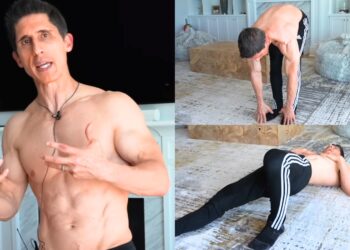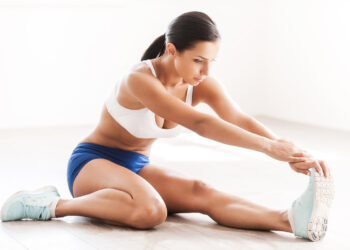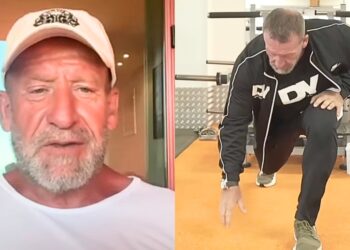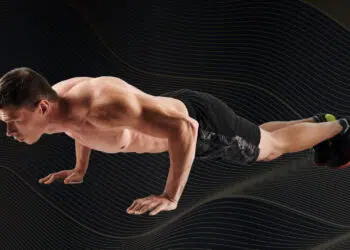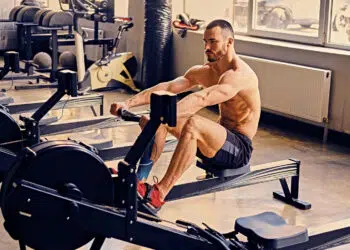A stretch that takes me back to memory lane and one I so dreaded from my Jiu-jitsu and grade school physical education days (But didn’t need as much as I do today) but now appreciate as I realize youth won’t make us invincible forever.
The seated groin stretch, aka butterfly pose, or (Baddha konasana in yoga terms) is a basic inner thigh, hip muscle opener that stretches and releases tension throughout the body. Sitting on your rump all day is fine as a kid but adulthood is less forgiving on the human anatomy, and unless you want to be like the Tin Man and dig yourself a deeper hole, well, let’s just say groin stretches combined with regular activity shouldn’t be optional.
Trust me, sitting and writing these guides rears its ugly head if I don’t create balance with my daily activities.
Healthy hips and adductors (Muscles that pull the legs inward) are vital for every day, multidirectional movement patterns, optimal physical performance, well-being, longevity, injury reduction, and just walking around pain-free. Bonus benefit: Increase your groin flexibility and deepen your lotus pose padmasana and variations too!
Now let’s master this basic essential stretch!
How To Do The Seated Groin Stretch
While the traditional unassisted seated groin stretch can be done safely and effectively, today we want to offer you a potentially safer, less painful, and still effective version that you can still use to progress and increase hip flexibility.
Level Up Your Fitness: Join our 💪 strong community in Fitness Volt Newsletter. Get daily inspiration, expert-backed workouts, nutrition tips, the latest in strength sports, and the support you need to reach your goals. Subscribe for free!
Steps
- Grab two same size pillows and sit on a comfortable but firm surface (Exercise mat, carpet, or gym flooring).
- Fold the pillows in half and wedge them under your butt bones on each side.
- Allow your legs to relax into the pillows, sit tall, lengthen your spine and focus on slow breathing.
- If needed, gently press down into your legs to deepen the stretch.
You’ll know you’re doing it right if you feel a stretch on the entire inside of your thighs.
Don’t worry so much about the seconds. Relax in the position and let your body loosen up.
Watch a demonstration of this safer groin stretch technique.
Pro Tips
- Always warm up the target muscles with light physical activity before any stretching routine. This ensures that your muscles are pliable, and prevents injuries.
- You can also wedge yoga blocks under your legs to raise the knees, similar to how pillows are used in the video included above.
- Ideally, you’ll be able to lean your upper body forward to enhance the stretch. However, it is optional and you can still stretch your adductors really well while remaining upright during the exercise.
Muscles Involved In Seated Groin Stretch
Just be clear, groin stretches are not a muscle-building or strengthening technique. It’s merely used for the benefits of stretching several muscles and unlocking tight hips, which are essential to body health and function. Now let’s talk about the muscles of focus in this pose.

Adductors
The adductor muscles create the sexy shape of your inner thighs, especially if you don’t skip leg day or are just genetically blessed with good legs. But more importantly, adductors are several muscles that primarily swing the leg inward towards the center of your body.
These muscles are:
- Adductor longus
- Adductor Brevis
- Adductor Magnus
- Adductor Minimus
- Gracilis
- Pectineus
- Obturator externus
Well equipped for strong medial thigh movement, adductors extend from part of the pelvis down to the tibial aspect of your leg. Other roles of adductors are stabilizing the pelvis during standing movements, lateral rotation of the thigh, flexion and extension of the thigh, and the gracilis can help flex the knee.
In This Exercise:
- Target muscle group: Adductors
- Type: Stretch, muscle health
- Mechanics: Isolation
- Equipment: Exercise mat and two same size pillows (Optional)
- Difficulty: Intermediate
Benefits of Seated Groin Stretch
You can expect a diverse range of benefits from stretching your hips which we discuss below.
Crack the code for your hip issues
While groin stretches are not enough to benefit your entire hip structure and function, they help maintain optimal muscle health in the important groin and inner thigh area. Plus, as mentioned, adductors contribute to thigh extension and flexion, as well as knee flexion.
So there are several telltale signs of tight hip adductors:
- Pain in the inner hips, groin, knees, and back, and when you abduct the leg
- On and off discomfort in your inner legs
- Lack of mobility or stiffness in hips
- Muscle weakness
- Limping when walking
- One side of the hip bothers you
- Groin pulls
- Legs bow out when doing squats, etc
Now, most people won’t be immobilized by hip tightness, and they can still move around. But it typically causes nagging discomfort. A proper stretching and movement regime can reverse that.
Stay in the game
According to research, hip and groin injuries often result in significant time sidelined from sporting activities (1). While physical traumas are often inevitable due to athletic physical demands, stretching helps to keep the muscles and joints flexible, mobile, loose, and more resilient to potential injuries.
Supports balanced hips and movement
When any muscle is tight it can affect your movement. After all, did you know that the muscles pull your joints to cause different limb movement?
Tense hip muscles can cause functional imbalances, movement asymmetries, uneven gait (Walking) patterns, and more. Just like sitting too long, and bad posture have negative consequences. It’s the same concept.
Therapeutic
Stretching your muscles is not only physical, but it’s one of the most convenient techniques for mental relaxation too. Akin to how weight training releases stress and pumps those endorphins, lengthening your muscles releases tension which gives immediate relief, and that “feel good” effect.
Common Mistakes During Groin Stretch
There’s so much room for error in an exercise like the groin stretch. From forcing the knees down to crappy posture, you’ll be hurting more than improving yourself. Avoid these bad form habits.
Sitting in the pain
Assuming this would be an issue mostly for newbies attempting the traditional groin stretch technique, don’t stay in the stretch if you’re feeling burning and pain in your groin and hips. Get out of it and use the pillows or cushions as props to ease yourself into the fullest potential of a groin stretch.
Cranking down on the knees
While you can always force the hips and knees into a deeper stretch, you could damage something. Hence why many health sources and fitness experts highly recommend doing a few minutes of light activity to warm up your muscles before stretching.
But it’s not just muscles, your joints, ligaments, and tendons need ample time to adapt to larger ranges of limb movement.
Level Up Your Fitness: Join our 💪 strong community in Fitness Volt Newsletter. Get daily inspiration, expert-backed workouts, nutrition tips, the latest in strength sports, and the support you need to reach your goals. Subscribe for free!
So next time you think about shoving the knees down, remember that you may be slowly damaging those areas. Then you’ll pay later on when you get random pains.
Slouched posture
Stretching your back and spine is one thing, but bad posture when sitting in a groin stretch is a bad thing. It stresses the disks in your lower back, builds tension in your neck and shoulders, and is a bad habit.
Holding your knees up
If you don’t understand why you’re doing the groin stretch, you may make this mistake as many do. You shouldn’t be lifting the knees and closing the hips as it defeats the purpose. This is fine if just sitting on the floor but it does nothing beneficial.
Again, grab your pillows or yoga blocks and give up control of your legs.
Bouncing
You may see athletes bouncing in a stretching position. However, they’re likely trained to do this safely and effectively. We don’t recommend this for groin stretches. You could cause more tightness and injure yourself especially when doing this in a groin stretch.
We want you to do a static stretch instead where you hold still in the pose, and slowly move deeper into it to achieve greater muscle lengthening!
Variations and Alternatives of Seated Groin Stretch
Here are other exercises that you can do to relieve your hips, stretch out your body, and maintain long-term mobility. There are more but we believe the following options are plenty for anyone starting out and wanting to get a wicked good crotch stretch.
Seated groin stretch on yoga block
You can also sit on a yoga block to lift yourself higher which will do two things. Helps those with less flexibility more easily perform the stretch, and allows you to maintain an upright posture and prevent lower back pain.
Another way you can use a block is by placing it on the ground in front of you and pressing both feet together into the block. This may enhance the stretch in your adductors.
Adductor stretch
One you probably never thought of doing, but here it is. Adductor stretches are a more unconventional way to stretch your crotch, but we think you’ll appreciate the option. And if there was an award for most straightforward, non-discreet groin stretch, this would be the winner.
Adductor stretch/lying wall split
A supported variation of the adductor stretch (The first variation), your legs are held in position with a wall. If you have a smooth wall, you can wear socks to slide your heels up and down, otherwise, just move them to the desired position.
And as mentioned in the video example below, it allows gravity to do the work for you. Nothing like passive benefits…
Steps
- Sit with your body sideways close up to a wall.
- Then as you lie on your back, bring both legs up and turn your body so that you can place your butt, the back of your legs and heels against the wall. Scoot your buns forward if needed to get closer. Keep your legs straight if you can.
- Push your lower back down to flatten it against the floor.
- Now gradually spread your feet apart and open the legs wide until you feel a stretch on the inside of your thighs.
- Flex your quadriceps (Front thigh muscles), and aim to push your knees into the wall.
- Sit in this position until you feel the muscles loosen. Then spread the legs a little wider if you need more stretch.
- Use your hands to carefully help you come out of the position, bringing one leg down at a time.
Aim for 20-30 seconds in the stretch position, and do 3-5 rounds.
Pro Tip: Point your feet in and out to feel the stretch differently.
Wide stance adductor stretch
We served you seated and lying variations so far, and now we’ll bring out the standing groin stretch. What’s nice about being on your feet is you can control the intensity of the stretch with your body weight and legs. Not to mention, with the hips in full extension, you can get a better overall stretch of the inner leg.
Now let’s go over the technique…
Steps
- Stand with your feet wider than shoulder width.
- Take a step forward with either foot so that one leg is slightly in front of the other.
- Now bend the front leg and come into a side lunge until you feel a stretch in the opposite leg adductor muscles. The key here is keeping the non-lunging leg straight. Tense your quad to help keep the knee extended.
- Hold this position for 20-30 seconds and gently deepen the stretch if needed.
- Then make sure to do the same for the opposite side.
Pro Tip: Experiment with shifting your upper in various directions to feel a stretch in a different part of the inner thighs.
Spread leg forward fold Upavistha Konasana
If you thought the seated groin stretch was tough, you haven’t tried a full seated forward fold upavistha konasana! Also a seated variation, but with straight legs spread wide to emphasize the inner thighs, the objective is to fold your upper body forward and lengthen the adductor muscle fibers.
Here’s an in-depth step-by-step technique breakdown. Make sure not to skip any steps for max effectiveness!
Steps
- Begin by sitting on your mat with the knees bent, feet flat on the floor, and arms resting over your legs.
- Straighten your legs out in front of you, then spread them wide.
- Use your hands and gently adjust your glutes by pulling them out to ensure you’re able to maintain an upright posture and lengthened torso without limitation.
- Flex your feet by pulling the toes back toward your ankle, and press the heels into the ground.
- Now place your fingertips behind your butt on the floor, and pull the shoulder blades slightly toward each other, and down. Then lift your chest up.
- Hold the stretch.
- If you’re ready for a deeper stretch, place your hands in front of you on the floor, then slowly walk your hands forward as much as you comfortably can.
- Now allow your upper body to sink down toward the floor to accentuate the stretch. But remember to maintain a lengthened back, not slouching over.
- From here, if you do not have the flexibility to descend further, you can use a yoga bolster and/or stacked blankets for support.
- Gently, lie your head down, looking to either side, and rest your elbows on the floor with your palms facing up.
- Let your entire body relax and sink into the cushions, allowing your arms to also become heavy.
- Bring awareness to your groin, feeling the wide position of your legs, while allowing your lower body to sink down into the floor.
- Stay here for 5 minutes.
- To come out of the pose, turn your hands over onto your palms, then slowly sit up, walking your hands back toward you for support.
- Before you finish the pose, and if you’re comfortable, from the sitting position, place the bolster/blankets on one leg, and lie your head down to that one side for 3-5 minutes. Repeat on the other side.
FAQ’s
How long should I hold the seated groin stretch position?
There’s no perfect amount of time to hold a groin stretch. However, you do want to allow the muscles time to elongate, and open up. On the flip side, if your hips hurt when you come out of the stretch, you’ve probably held the stretch for too long.
For general routine stretching, the American College of Sports Medicine recommends holding a stretch between 10-30 seconds, repeating this 2-4 times per session (2). Once you become more flexible, you can increase the duration beyond 30 seconds and even up to 3 minutes per stretch.
Longer stretching could help fast track release of problem areas. However, if you’re experiencing severe pain and tightness, you should consult a medical professional.
How often should I stretch my adductor/groin area?
You may stretch less frequently or more often depending on the tightness of your adductors. But just don’t overdo it by spending hours every day stretching the same muscles. You’ll have to determine what’s an adequate, and not excessive amount of stretching for your situation.
However, 2-3 days per week or stretching daily in shorter durations works good for most.
When is the best time of day to do seated groin stretch?
As long as you do a proper warmup routine beforehand, you should be fine doing the seated groin stretch any time of the day.
Is it normal to feel pain when doing groin stretches?
It’s normal to feel the muscles stretching and minor discomfort isn’t necessarily bad. It’s when you feel uncomfortable pain and burning in the groin area which means you should use props to elevate your knees for a pain-free progression technique.
Then, as you improve adductor health and flexibility, you can gradually lower your knees until you can perform a deeper seated groin stretch.
Below you can find some common questions about the seated groin stretch.
Wrapping Up
If it’s been a while since you did a seated groin stretch, well, you’re welcome, and we’re happy to take you back down memory lane (It’s for your own good).
While technically optional, we think of groin based stretches more as a necessity, as is the integrity, movement, and performance of your adductor thigh muscles. Most people have no idea what’s causing their walking pains, limping, and movement limitations. It could be your adductors!
So give the muscles in your medial thigh a good stretch and the seated groin technique, and combine it with other variations, more physical activity, and leg strengthening exercises to bulletproof your hips.
Interested in measuring your progress? Check out our strength standards for Side Lunge, Squat, Lunge.


